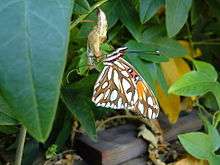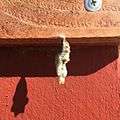Gulf fritillary
| Gulf fritillary | |
|---|---|
| | |
| Upperside | |
 | |
| Underside | |
| Scientific classification | |
| Kingdom: | Animalia |
| Phylum: | Arthropoda |
| Class: | Insecta |
| Order: | Lepidoptera |
| Family: | Nymphalidae |
| Tribe: | Heliconiini |
| Genus: | Agraulis (Boisduval & Le Conte, 1835) |
| Species: | A. vanillae |
| Binomial name | |
| Agraulis vanillae (Linnaeus, 1758) | |
The Gulf fritillary or passion butterfly (Agraulis vanillae) is a bright orange butterfly of the family Nymphalidae and subfamily Heliconiinae. That subfamily was formerly set apart as a separate family, the Heliconiidae. The Heliconiinae are "longwing butterflies", and like other longwings this species does have long, rather narrow wings in comparison with other butterflies. It is not closely related to the true fritillaries, however. It is the only member of genus Agraulis.
Description
The Gulf fritillary is a medium to large butterfly, with a wingspan of 6–9.5 cm (2.4–3.7 in). Its underwings are buff, with large silvery spots.[1] It takes its common name from its migration over the Gulf of Mexico.
It was first illustrated by Maria Sybilla Merian in Surinam.[2]
The Gulf fritillary is commonly seen in parks and gardens, as well as in open country. Its range extends from Argentina north through Central America, Mexico, and the Caribbean to the southern United States, as far north as the San Francisco Bay Area on the west coast. It is occasionally farther north.[3]
Larva

The larva is a caterpillar which grows to approximately 4 cm (1.6 in) in length. It is bright orange in color and covered in rows of black spines. The spines are soft to the touch and do not sting, but the larva is poisonous if eaten. The larva feeds exclusively on species of passionflower, such as maypop (Passiflora incarnata), yellow passionflower (P. lutea), and running pop (P. foetida).
Black and orange stripes warn predators of the toxicity of the caterpillar which protects it from predators.[4] Many birds avoid it.[5] Some specialized insects such as paper wasps and praying mantis' have been observed feeding on it, however, and larger caterpillars sometimes eat smaller ones. This species belongs to the "orange" Batesian mimicry complex.
The chrysalis is approximately 3 cm (1.2 in) long. It is mottled brown and looks like a dry leaf.
The cultivation of passionflowers has enabled the Gulf fritillary to extend its range, into California, for example.
Chrysalis

When the time comes for the caterpillar to create its chrysalis it turns a greyish color and begins to spin a silk-like substance into a ball on top or against a malleable surface. It then attaches its rear end to the "silk" lump and hangs upside down in a "j" position. By small contractions of the muscles it begins to shed its skin and head revealing a soft pinkish tan form. Quickly the soft form hardens and becomes greyish brown. The chrysalis stays in this form for eleven to twenty-one days. After that period of time, a small crack begins to form at the tip of the chrysalis revealing the butterfly's head. It continues to slowly move down through the bottom of the chrysalis until its legs are free to cling onto the shell of the chrysalis and pull itself the rest of the way out. Much like the monarch butterfly, it begins to pump the fluids from its bulging abdomen into its shriveled wings. When its wings are fully expanded it releases excess fluids from its abdomen. For the next ten to fifteen minutes it stays still and allows its wings to dry. Finally it fans its wings out and takes flight.
Gallery
-

Profile of wings in sunlight
-

Fritillaries Mating
-

Egg
-
Caterpillar
-

Fritillary feeding on nectar from passion flower
-

Agraulis vanillae in its chrysalis form, seen in Inglewood, California.
-

Agraulis vanillae larvae preparing for their metamorphoses.
-
A. v. insularis Grand Cayman
References
- ↑ Rauser, C. L., & Rutowski, R. L. (2003). Male-specific structures on the wings of the Gulf fritillary butterfly, Agraulis vanillae (Nymphalidae). Journal of the Lepidopterists' Society 57(4): 279–283.
- ↑ Merian, Maria Sybilla (1730). Metamorphosis insectorum Surinamensium. Amsterdam: Jean Frederic Bernard. p. 20. Retrieved 28 June 2016. Plate 25
- ↑ Whan, P. W., & Belth, J. E. (1992). Second Ohio record of Agraulis vanillae (Lepidoptera, Nymphalidae). Ohio Journal of Science 92(4): 121–122.
- ↑ Ross, G. N., Fales, H. M., Lloyd, H. A., Jones, T., Sokoloski, E. A., Marshall, B. K., et al. (2001). Novel chemistry of abdominal defensive glands of nymphalid butterfly Agraulis vanillae. Journal of Chemical Ecology 27(6): 1219–1228.
- ↑ Pinheiro, C. E. G. (1996). Palatability and escaping ability in Neotropical butterflies: tests with wild kingbirds (Tyrannus melancholicus, Tyrannidae). Biol. J. Linn. Soc. 59(4): 351–365. HTML abstract
- Darby, Gene (1958). What is a Butterfly. Chicago: Benefic Press. p. 36.
External links
| Wikispecies has information related to: Agraulis vanillae |
| Wikimedia Commons has media related to Agraulis vanillae. |
- Tree of Life: Agraulis vanillae
- Gulf fritillary, University of Florida IFAS
- Gulf fritillary, San Diego Natural History Museum
- Gulf friillary, Butterflies of Canada
- How to Raise Gulf Fritillary Butterflies, WikiHow